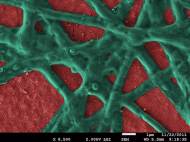Algal protein gives boost to solar hydrogen generation
 Photo-electrochemical cells (PEC) use sunlight to electrochemically split water in order to generate hydrogen in direct manner, and they are usually made of semiconducting materials. Researchers from Switzerland and US used nature as inspiration to optimize the process by developing iron oxide electrodes that are conjugated with a protein from blue-green algae (also known as cyanobacteria).
Photo-electrochemical cells (PEC) use sunlight to electrochemically split water in order to generate hydrogen in direct manner, and they are usually made of semiconducting materials. Researchers from Switzerland and US used nature as inspiration to optimize the process by developing iron oxide electrodes that are conjugated with a protein from blue-green algae (also known as cyanobacteria).
Researchers at Empa’s Laboratory for High Performance Ceramics (LHPC), collaborated with colleagues at the University of Basel and at Argonne National Laboratory in the US, to develop nano-bio PEC electrode by adding phycocyanin (a protein from blue-green algae) to iron oxide in order to double its water splitting efficiency. Iron oxide is already a promising electrode material for PEC because it can utilize full specter of sunlight, unlike TiO2 which uses only the UV part of solar radiation.
“I was inspired by the natural photosynthetic machinery of cyanobacteria where phycocyanin acts as a major light-harvesting component. I wanted to make artificial photosynthesis using ceramics and proteins”, said Debajeet K. Bora, who designed the new electrode during his PhD thesis at Empa. “The concept of hematite surface functionalization with proteins was completely novel in PEC research.”
Since photocatalysts are designed to destroy organic pollutants, you could expect that biomolecules would be destroyed when they are exposed to them, the alkaline environment, or the strong illumination. However, these organic molecules manage to do more than merely survive those conditions.
“There seems to be a delicate balance where organic molecules not only survive harsh photocatalytic conditions, but even convey an additional benefit to ceramic photocatalysts: They double the photocurrent. This is a big step forward”, said Artur Braun, group leader at Empa’s LHPC and principal investigator of the study.
The researchers claim their finding does exhibit long-term stability, and they hope it will be used in various hybrid photoanode for photo-electrochemical applications. Bora said he will continue the research he started at Empa early next year during a postdoc at the University of California, Berkeley.
For more information, read the article published in the journal Advanced Functional Materials named: “Functionalization of Nanostructured Hematite Thin-Film Electrodes with the Light-Harvesting Membrane Protein C-Phycocyanin Yields an Enhanced Photocurrent”.









Hydrogen is the future energy carrier.
Dr.A.Jagadeesh Nellore (AP),India
E-mail: anumakonda.jagadeesh@gmail.com